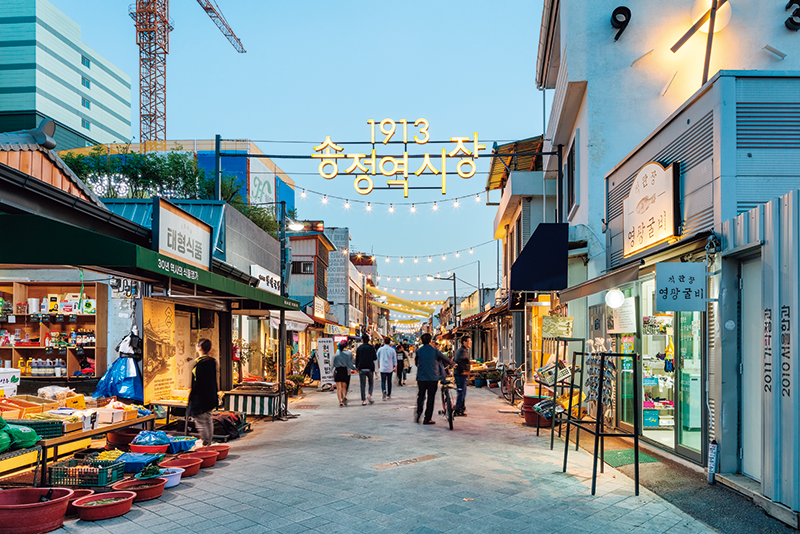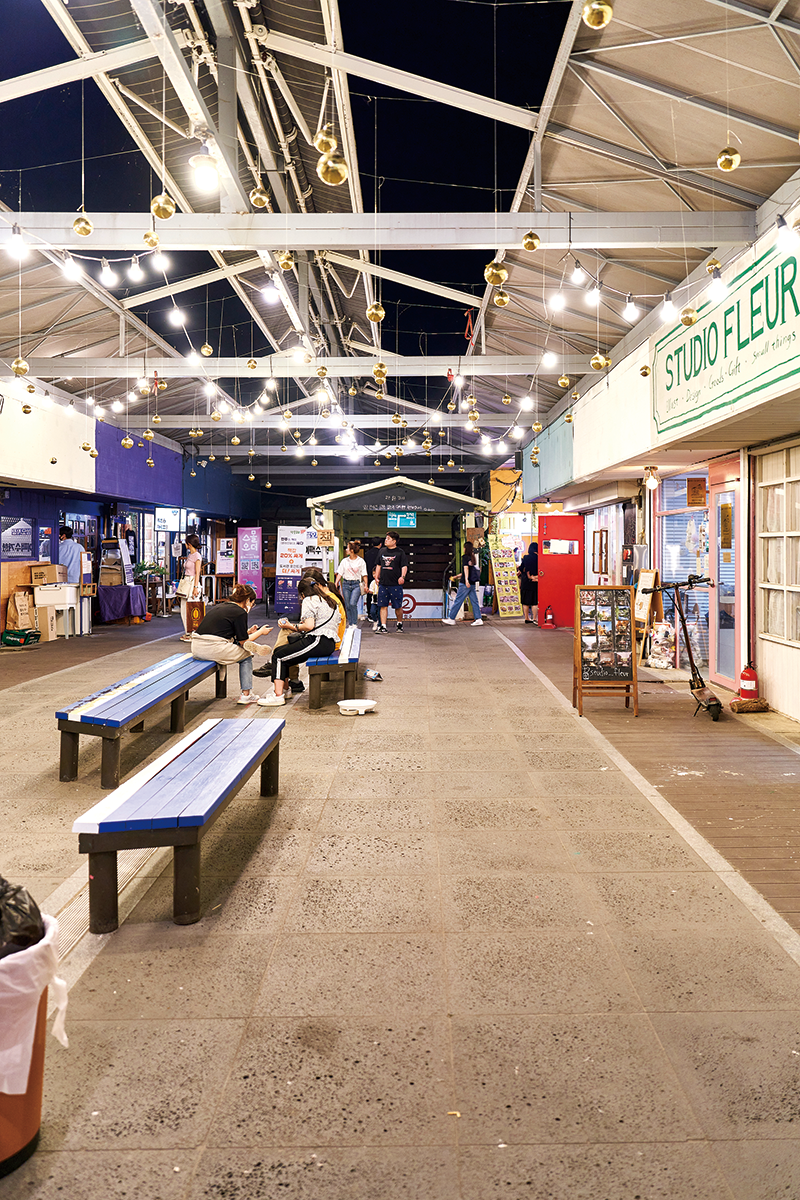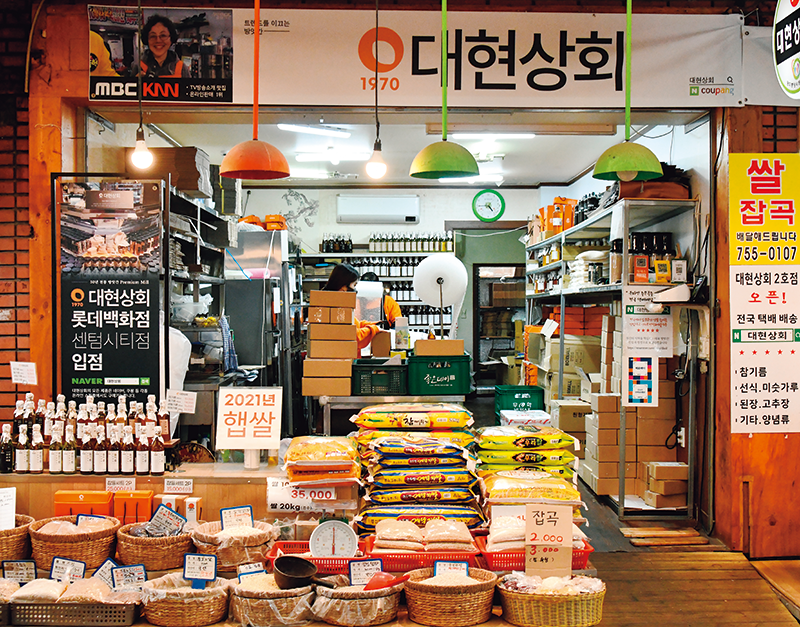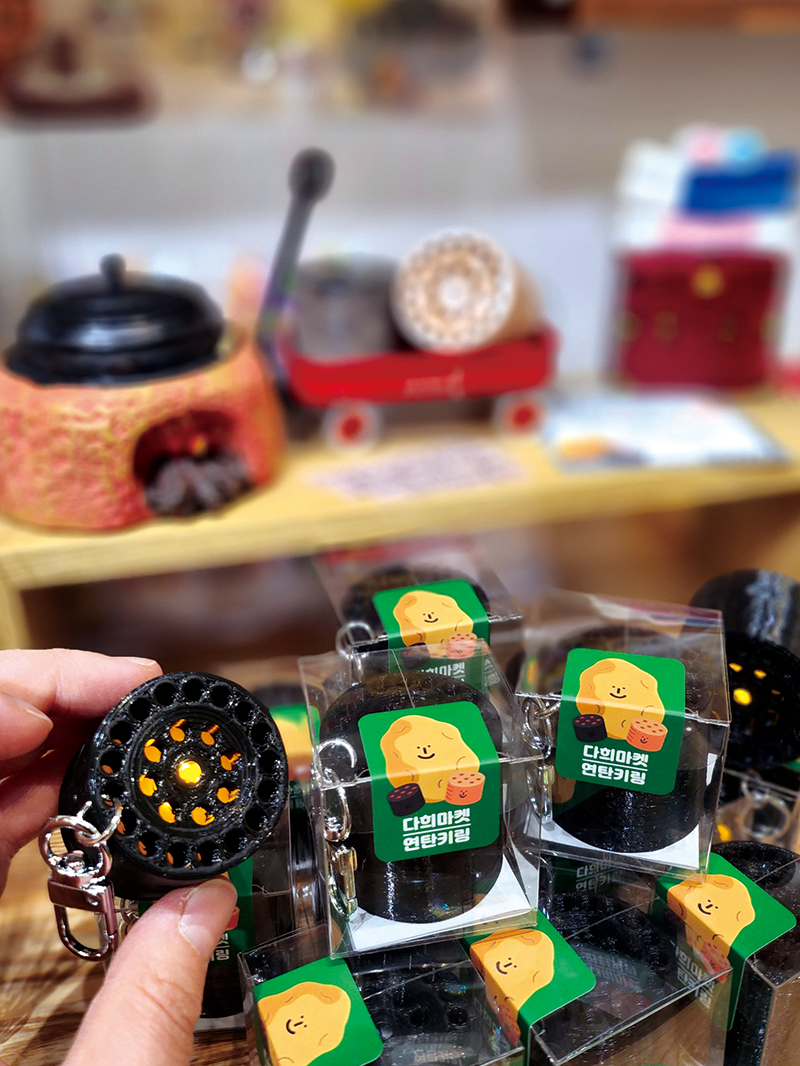More and more young people open their own stores or take over their family’s businesses in traditional markets. This new generation of shop owners is elevating the markets’ competitiveness by using online platforms and offering both time-honored and new goods that combine high quality and attractive design.

The 1913 Songjeong Station Market in the southwestern city of Gwangju, boasts a 110-year history. It underwent a major facelift in the mid-2010s. The renovation, a joint project of the local government, Hyundai Card, and Philobiblon Associates, has succeeded in attracting young merchants.
© Hyundai Card, Philobiblon Associates
The Dongbu Traditional Market in Seosan, South Chungcheong Province, is home to a family store whose history spans nearly 70 years. Specializing in dried products such as laver and gamtae, a green seaweed with a nutty flavor, the store has been passed down through three generations. The current owner left his hometown of Seosan following high school. After working in an array of jobs, he returned to continue the family enterprise. To gain a firm grasp of the business, he committed to learning about all the intricacies of production and distribution for more than a decade.
There are about twenty such young vendors at this market—the heirs of a broad range of family businesses. Ranging from fried chicken restaurants to seafood stores and butcher shops, they have helped the market enjoy a resurgence.
At the Jeil Market in the city of Uijeongbu in Gyeonggi Province, a store specializing in ready-made banchan, or side dishes, has been passed down over three generations. The present owner joined the business to assist his mother. Today, he continues to prepare various side dishes by hand, including kimchi, in the same way his mother and grandmother used to do over the nearly seven decades of the store’s existence.
In the past, children of shop owners in traditional markets were reluctant to carry on their family’s business. But now, a major shift is underway. Equipped with creative talent, business instincts, and technological skills, the young generation of today is recognizing the markets’ potential as platforms to realize their ambitions and goals. They do not simply regard them as a means of livelihood but as an opportunity to create brands that reflect their identities and values.
By reconciling old traditions with the modern world, the new crop of young shop owners is helping traditional markets finally shake off outdated perceptions about them. They are no longer regarded as places catering solely to an older demographic where young and affluent consumers are rarely seen navigating the aisles. The new generation has introduced more diversified products and services that both reflect and reshape the character of traditional markets.
PROMOTING CHANGE

The Youth Mall on the second floor of Nambu Market in Jeonju features atypical businesses for a traditional market, including a bookstore, souvenir shop, and craft workshop. Established in 2012 through public and private cooperation, the mall is a nationwide model for the revitalization of traditional markets.
© Twinkia
The increasing number of young people embracing the opportunity to preserve their family legacy melds with proactive government efforts to breathe new life into traditional markets.
The Jeonju Nambu Market, one of the most important traditional markets in North Jeolla Province, boasts a space especially designed to bring together young vendors under one roof. It is called the “Youth Mall” and represented the first of its kind when the government launched the initiative in 2012 to boost the struggling market. Today, the modest-sized mall offers a diverse range of businesses, from restaurants, bars, and cafés to bookstores and souvenir shops.
The motto “Earn Modestly, Live Abundantly,” displayed at the Youth Mall’s entrance, encapsulates the mindset of these young vendors. They prioritize creating a vibrant space filled with captivating stories over being fixated on maximizing profits. The atmosphere at the market has undergone a drastic change since their arrival, leading other vendors to adopt a more customer-centered approach by offering new services such as delivery and shipping. Moreover, the arrival of young shop owners has fostered a mutually beneficial relationship among all vendors who have agreed to buy and sell raw materials together at a lower cost.
Many young vendors who have found success at Nambu Market’s Youth Mall have expanded their businesses by opening stores in other locations. Some of them have even embraced the role of mentors by offering guidance to new entrepreneurs at the Youth Mall. By sharing their experience and know-how with them, these vendors actively contribute to the greater prosperity of the entire market.
MODERN MODE
Driven by a clear vision, younger generations perceive traditional markets as blue oceans of untapped opportunity, as their business strategies suggest. Thanks to being tech-savvy, they have no trouble using the internet and social media to reach far beyond their local community and connect with customers all over the country. Moreover, since they are not firmly attached to old ways, they are also more open to exploring new business ventures that may not have been conventionally associated with traditional markets.
Ever since its opening in 1912, the Central Market in Sangju, North Gyeongsang Province, has played a pivotal role in the local economy. A few years ago, as the city’s aging population and residents’ migration to other places became an existential threat to the market’s future, ten young vendors decided to move in. They set up businesses not ordinarily associated with a traditional market, with their eclectic mix including a flower shop, a vegan dessert café, and a photo studio.
Not only have they chosen unusual ventures, but the same could be said of their business models. The owner of the clothing store Lounge Ju, for example, conducts livestreams to showcase the store’s own merchandise as well as products from other brands.
In today’s business environment, where promotional tools like social media, live commerce, and YouTube abound, this group of young vendors strives to captivate consumers through a mixture of content, such as vlogs, which allow them to share glimpses into their daily lives. This kind of innovative marketing approach not only helps them grow their own businesses but also works as a driver of change within the market.
ATTRACTIVE OPTION

Daehyeon Sanghoe at Mangmi Central Market in Busan is a store specializing in dried goods, including different types of flour. Thanks to her entrepreneurial spirit, the young owner established her own brand by selling high-quality, elegantly designed products online.
Courtesy of The Korea Federation of Small and Medium Business
Even young people who do not have family ties to traditional markets see them as a compelling option. Those in need may qualify for government and local assistance such as reduced rent costs, start-up funding, and consultancy services, all of which have proven to be very effective. That makes it much easier for them to realize their dream of starting their own business than if they had to wrestle with the high cost and logistics of commercial real estate.

Vendors in the Youth Mall at Sabuk Market in Jeongseon, Gangwon Province, sell products inspired by the region’s history as a coal-mining center. A coal briquette-shaped keychain is a bestseller at Dahee Market, a souvenir shop in the Youth Mall.
© Dahee Market

The Youth Mall at the Central Market in the city of Samcheok is a popular east coast destination thanks to its quaint workshops, hip cafés, and trendy restaurants. This photo shows a gift set sold at a store called Chou Chou Macaron.
© Chou Chou Macaron
Many in the growing league of young owners use online shopping platforms and web portals to expand their customer base beyond their local area. They also organize events that benefit the greater community. While not all of them succeed, young vendors perceive traditional markets as fertile ground for opportunities and continuously seek new ways to overcome obstacles through trial and error.
Many challenges remain to keep traditional markets thriving, such as expanding operating hours and upgrading infrastructure, including parking capacity. However, the influx of young people seeking to forge their own paths will contribute to the revitalization of local economies and the sustainable growth of traditional markets. Thanks to the innovative ideas brought forth by this new cohort of young vendors, there is every reason to be optimistic about the future of traditional markets in South Korea.